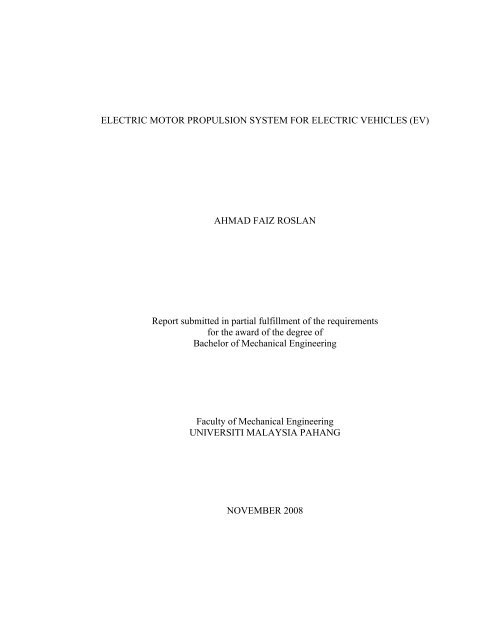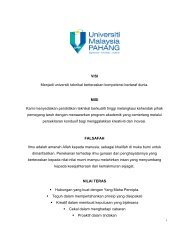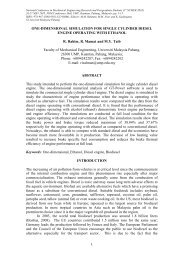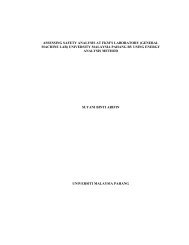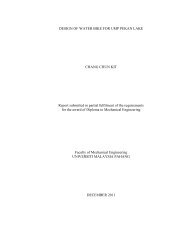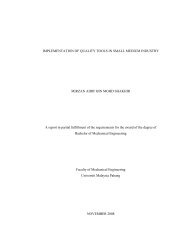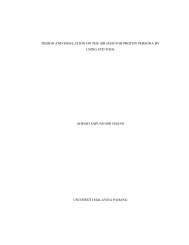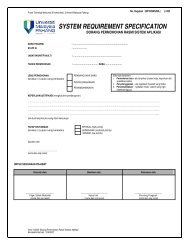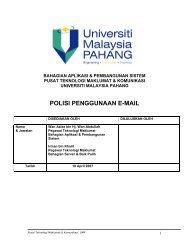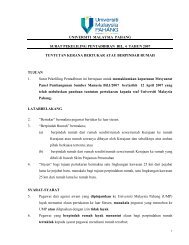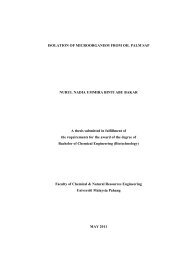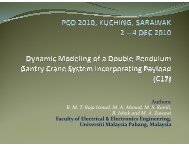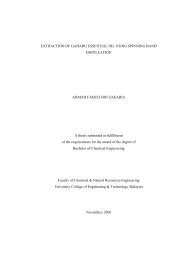AHMAD FAIZ ROSLAN Report submitted in partial fulfillment of the r
AHMAD FAIZ ROSLAN Report submitted in partial fulfillment of the r
AHMAD FAIZ ROSLAN Report submitted in partial fulfillment of the r
- No tags were found...
Create successful ePaper yourself
Turn your PDF publications into a flip-book with our unique Google optimized e-Paper software.
iELECTRIC MOTOR PROPULSION SYSTEM FOR ELECTRIC VEHICLES (EV)<strong>AHMAD</strong> <strong>FAIZ</strong> <strong>ROSLAN</strong><strong>Report</strong> <strong>submitted</strong> <strong>in</strong> <strong>partial</strong> <strong>fulfillment</strong> <strong>of</strong> <strong>the</strong> requirementsfor <strong>the</strong> award <strong>of</strong> <strong>the</strong> degree <strong>of</strong>Bachelor <strong>of</strong> Mechanical Eng<strong>in</strong>eer<strong>in</strong>gFaculty <strong>of</strong> Mechanical Eng<strong>in</strong>eer<strong>in</strong>gUNIVERSITI MALAYSIA PAHANGNOVEMBER 2008
iiSUPERVISOR’S DECLARATIONWe hereby declare that we have checked this project report and <strong>in</strong> our op<strong>in</strong>ion thisproject is satisfactory <strong>in</strong> terms <strong>of</strong> scope and quality for <strong>the</strong> award <strong>of</strong> <strong>the</strong> degree <strong>of</strong>Bachelor <strong>of</strong> Mechanical Eng<strong>in</strong>eer<strong>in</strong>g.Signature: …………………………………………..Name <strong>of</strong> Supervisor : Pr<strong>of</strong> Madya Dr Rosli B<strong>in</strong> Abu BakarPosition: SupervisorDate : 5 November 2008Signature: ……………………………………………Name <strong>of</strong> Panel : Mr Devarajan A/L RamasamyPosition: PanelDate : 5 November 2008
iiiSTUDENT’S DECLARATIONI hereby declare that <strong>the</strong> work <strong>in</strong> this report is my own research except for quotationsand summaries which have been duly acknowledged. The report has not been acceptedfor any degree and is not concurrently <strong>submitted</strong> for award <strong>of</strong> o<strong>the</strong>r degree.Signature: ……………………………….Name <strong>of</strong> Candidate : Ahmad Faiz RoslanID Number : MA 05088Date : 5 November 2008
ivACKNOWLEDGEMENTBismillahirrahmanirrahimSpecial thanks to my supervisor, Pr<strong>of</strong> Madya Dr Rosli B<strong>in</strong> Abu Bakar, and myco-supervisor, Mr Vannebula Eka Indraguna for <strong>the</strong>ir <strong>in</strong>spiration, commitment,encouragement, support and guidance <strong>in</strong> order to make this <strong>the</strong>sis successful.Many thanks to Dr Yusnita Rahayu, Mr Ismail B<strong>in</strong> Ali, and Mr Devarajan A/LRamasamy for <strong>the</strong>ir help and lend me <strong>the</strong>ir valuable time.Beloved thanks for my fa<strong>the</strong>r, Mr Roslan Dahari and my mo<strong>the</strong>r, Siti RamnahB<strong>in</strong>ti Baba and all <strong>of</strong> my sibl<strong>in</strong>gs for <strong>the</strong>ir f<strong>in</strong>ancial and spiritual support.Naturally, many thanks to my fellow friend, colleagues and whose direct or<strong>in</strong>direct to helps me complet<strong>in</strong>g this project. May God bless all <strong>of</strong> you.
vABSTRACTIn a bid to perform electric vehicle model<strong>in</strong>g <strong>in</strong> terms <strong>of</strong> propulsion system <strong>of</strong> <strong>the</strong>electric motor, <strong>the</strong> calculation and <strong>the</strong> analysis <strong>of</strong> vehicles dynamics have been done. Itswill concluded <strong>the</strong> suitable motor that will used to move <strong>the</strong> specific vehicles, ISWARA.Through <strong>the</strong> literature review, this <strong>the</strong>sis presented <strong>the</strong> <strong>in</strong>troduction <strong>of</strong> electric vehiclesand <strong>the</strong> major components <strong>of</strong> its system. Besides that, it will discuss <strong>the</strong> propulsionsystem for electric motor <strong>of</strong> <strong>the</strong> electric vehicles. Next, calculation and analysis beendone to f<strong>in</strong>d <strong>the</strong> requirement power and force to move <strong>the</strong> vehicle <strong>in</strong> fixed velocity.Results get from <strong>the</strong> calculation will be used to f<strong>in</strong>d <strong>the</strong> characteristics <strong>of</strong> electric motorand f<strong>in</strong>ally <strong>the</strong> suitable electric motor are selected. Simulation done to analysis <strong>the</strong>suitable motor ei<strong>the</strong>r it can perform and give <strong>the</strong> similar results compare to calculationmade before or not. At <strong>the</strong> end <strong>of</strong> this <strong>the</strong>sis, conclusion is made due to <strong>the</strong> results getfrom <strong>the</strong> simulation analysis. Recommendation <strong>in</strong> improv<strong>in</strong>g <strong>the</strong> results from whole <strong>of</strong><strong>the</strong> project will also be discuss.
viABSTRAKDalam langkah menghasilkan model kenderaan elektrik yang terdiri daripadapembahagian sistem dalam motor eletrik, pengiraan dan analisa berkaitan dengand<strong>in</strong>amik kenderaan harus dibuat. Ia akan member jawapan kepada motor yang sangatsesuai digunakan untuk menggerakan kenderaan yang telah ditetapkan iaitu ISWARA.Melalui gambaran penulisan, kajian akan memperjelaskan tentang pengenalan untukkenderaan elektrik dan komponen-komponen pent<strong>in</strong>g dalam system kenderaan tersebut.Sela<strong>in</strong> itu, ia akan memb<strong>in</strong>cangkan pembahagian system untuk motor elektrik dalamkenderaan elektrik. Selanjutnya, pengiraan dan analisa akan dilakukan untuk mencarikeperluan kuasa dan tenaga bagi menggerakkan kenderaan dalam kelajuan yangditetapkan. Hasil daripada pengiraan akan digunakan untuk mencari ciri-ciri tertentuelektrik motor dan akhirnya elektrik motor yang sesuai akan dipilih. Simulasi dilakukanuntuk menganalisa adakah elektrik motor yang sesuai itu akan menjalankan danmemberikan keputusan yang serupa dengan hasil pengiraan yang dilakukan sebelum <strong>in</strong>iatau tidak. Diakhir kajian <strong>in</strong>i, keputusan akan dibuat berdasarkan hasil yang diperolehidaripada simulasi analisa. Cadangan untuk mebaikpulih hasil keputusan daripadakeseluruhan projek akan dib<strong>in</strong>cangkan..
viiTABLE OF CONTENTPAGESUPERVISOR’S DECLARATION iiSTUDENT’S DECLARATION iiiACKNOWLEDGEMENT ivABSTRACT vABSTRAK viTABLE OF CONTENT viiLIST OF FIGURES xLIST OF TABLES xiiLIST OF APPENDICES xiiiLIST OF SYMBOLS AND ABBREVIATIONS xivCHAPTER 1INTRODUCTION1.1 Introduction 151.2 Project background 181.3 Project objective 181.4 Project scope 181.5 Source <strong>of</strong> knowledge 191.6 Thesis outl<strong>in</strong>e 20CHAPTER 2LITERATURE REVIEW2.1 Electric vehicles 212.1.1 Hybrid electric vehicles (HEVs) 222.2 Battery 22
viii2.2.1 Battery formation 232.2.2 Battery capacity 232.3 Electric motor 242.3.1 S<strong>in</strong>gle-phase <strong>in</strong>duction motor (AC motor) 252.3.2 Brushless motor (DC motor) 282.4 Drivetra<strong>in</strong> 292.5 Transmission components 302.5.1 Gears 302.5.1.1 Ideal gearbox 302.5.2 Clutch 322.5.3 Brakes 322.6 Vehicles specification 332.6.1 Specifications for ISWARA 342.7 Energy management 372.7.1 Controller 372.7.2 Supercapacitor banks (SB) 382.7.3 Pulse-width modulation (PWM) 41CHAPTER 3METHODOLOGY3.1 Propulsion system algorithm 433.2 Vehicles performance model<strong>in</strong>g 433.2.1 Tractive force 433.2.2 Aerodynamics drag 443.2.3 Roll<strong>in</strong>g resistance force 453.2.4 Gravitational force 473.2.5 Acceleration force 483.2.6 Total Comb<strong>in</strong>ation 493.2.7 Calculation 513.2.7.1 Parameters 513.2.7.2 Total tractive force 523.2.7.3 Power requirement 533.2.7.4 Specification <strong>of</strong> motor 533.3 Comparison 553.3.1 Aerodynamics drag 55
ix3.3.1.1 Constant parameters 553.3.1.2 Variables parameters 553.3.1.3 Results 563.3.2 Roll<strong>in</strong>g resistance force 603.3.2.1 Constant parameters 603.3.2.2 Variables parameters 603.3.2.3 Results 61CHAPTER 4RESULTS AND DISCUSSION4.1 Characteristics <strong>of</strong> chosen motor 654.1.1 Typer 654.1.2 Power and torque 654.1.3 Tester motor 654.2 Methods test <strong>the</strong> motor 674.2.1 Simulation 674.2.1.1 Vehicles dynamics 684.2.1.2 Electric motor characteristics 694.2.1.3 Gear ratio distribution 704.2.1.4 Tyre and roll<strong>in</strong>g resistance distribution 714.2.1.5 Simulation model 724.2.2 Simulation results 734.2.2.1 Vehicle velocity (15kW) 734.2.2.2 Vehicle velocity (62.347kW) 74CHAPTER 5CONCLUSION AND RECOMMENDATION5.1 Conclusion 755.1.1 Vehicles contribution 755.1.2 Electric motor 755.2 Recommendation 765.2.1 Error 765.2.1.1 Causes 765.2.1.2 Solution 765.2.2 Efficiency <strong>of</strong> <strong>the</strong> motor 775.2.2.1 Apparatus or methods 77REFERENCES 78APENDICES A 80-83
xLIST OF FIGURESNO TITLE PAGE2.1 Electric vehicle system 212.2 Cross section for many type <strong>of</strong> motor <strong>in</strong> <strong>in</strong>dustries 262.3 Induction motor characteristic 272.4 Front-wheel drivetra<strong>in</strong> 292.5 Rear-wheel drivetra<strong>in</strong> 292.6 Specification <strong>of</strong> vehicle 352.7 Iswara picture (1) 362.8 Iswara picture (2) 362.9 Powertra<strong>in</strong> system for EV 402.10 Types <strong>of</strong> PWM 413.1 Required force versus velocity for 0.3 drag coefficient 563.2 Required force versus velocity for 0.2 drag coefficient 573.3 Required force versus velocity for 0.4 drag coefficient 583.4 Comparison <strong>in</strong> different drag coefficient 593.5 Required force versus velocity for 0.005 roll<strong>in</strong>g resistance 613.6 Required force versus velocity for 0.01 roll<strong>in</strong>g resistance 623.7 Required force versus velocity for 0.015 roll<strong>in</strong>g resistance 634.1 Tester motor (top view) 664.2 Tester motor (front view) 664.3 Tester motor (side view) 674.4 Iswara specification parameters 684.5 Electric motor parameter 694.6 Gear ratio parameter 704.7 Tyre parameter 71
xi4.8 Simulation model for Iswara 724.9 Vehicle velocity when us<strong>in</strong>g 15kW electric motor 734.10 Vehicle velocity when us<strong>in</strong>g 62.347kW electric motor 74
xiiLIST OF TABLESNO TITLE PAGE2.1 Comparison between AC motor and DC motor 252.2 Specification <strong>of</strong> motor 262.3 Characteristics <strong>of</strong> supercapacitor 393.1 Calculation for 0.3 drag coefficient 563.2 Calculation for 0.2 drag coefficient 573.3 Calculation for 0.4 drag coefficient 583.4 Calculation for 0.005 roll<strong>in</strong>g resistance coefficient 613.5 Calculation for 0.01 roll<strong>in</strong>g resistance coefficient 623.6 Calculation for 0.015 roll<strong>in</strong>g resistance coefficient 63
xiiiLIST OF APPENDICESNO TITLE PAGEA AC <strong>in</strong>duction motor datasheet 80-83
xivLIST OF SYMBOLS AND ABBREVIATIONSEV - Electric vehicleHEV - Hybrid-electric vehicleBEV - Battery-electric vehicleFCEV - Fuel cell-electric vehicleSB - Supercapacitor bankPWM - Pulse-width modullationT - TorqueF - Force - Tractive force - Aerodynamic drag - -Roll<strong>in</strong>g resistance forceGravitational force - Force gives l<strong>in</strong>ear acceleration - Force gives angular acceleration to rotat<strong>in</strong>g motor
15CHAPTER 1INTRODUCTION1.1 INTRODUCTIONTodays, as a human be<strong>in</strong>g transportation become an important role for gett<strong>in</strong>ga comfortable life. But, human not realize that next 50 years, global population will<strong>in</strong>crease from 6 billion to 10 million and <strong>in</strong> order aspects, <strong>the</strong> number <strong>of</strong> vehicles will<strong>in</strong>crease from 700 million to 2.5 billion. If all <strong>the</strong>se vehicles are propelled or get <strong>the</strong>irsources energy by <strong>in</strong>ternal combustion eng<strong>in</strong>es (ICEs), <strong>the</strong>n where will <strong>the</strong> oil comefrom? Where should <strong>the</strong> emission be dissem<strong>in</strong>ated? Would <strong>the</strong> sky be permanentlyblue? The gloomy answer to <strong>the</strong>se hard questions compel human to strive forsusta<strong>in</strong>able road transportation for 21 st century [4].Electric Vehicles (EV) is <strong>the</strong> vehicles that implemented <strong>the</strong> energy ga<strong>in</strong> from <strong>the</strong>propulsion electric source which can also be delivered by an electric mach<strong>in</strong>e. Itdef<strong>in</strong>itely emphasizes <strong>the</strong> benefits <strong>of</strong> electro-mechanical solutions. Nowadays, <strong>in</strong>automotive <strong>in</strong>dustry <strong>the</strong> f<strong>in</strong>d that EV is <strong>the</strong> most suitable be<strong>in</strong>g on <strong>the</strong> road because it isfriendly environment and can reduce <strong>the</strong> pollution accord<strong>in</strong>g to reduc<strong>in</strong>g <strong>the</strong>application <strong>of</strong> fuel or petrol. Beside that, EV is an extraord<strong>in</strong>ary and different fromo<strong>the</strong>r road vehicles. It <strong>in</strong>volve with electric propulsion and give a variation technology<strong>in</strong> order to save <strong>the</strong> world for pollution. EV are <strong>in</strong>clude with battery electric vehicles(BEVs), hybrid-elctric vehicles (HEVs), and fuel-cell electric vehicles (FCEVs) [5]. The idea<strong>of</strong> EV can be described as a multidiscipl<strong>in</strong>ary subject which covers broad and complexaspects. The core <strong>of</strong> this advance technologies are consist <strong>of</strong> chasis and body
16technology, propulsion technology, and energy source technology. That why it becomea tough task to write a <strong>the</strong>sis based on this multidiscipl<strong>in</strong>ary and advance studies.Development <strong>of</strong> BEVs, HEVs and FCEVs are forwards and get very well attentionfrom this wide world. But compare to this deviation <strong>of</strong> EV <strong>the</strong>y give different stages <strong>of</strong>development, different problem that appears, and different strategy to solve <strong>the</strong>problem. In BEVs, <strong>the</strong> ma<strong>in</strong> problem is about it batteries. BEVs system suitable for smallEV because it just give a short range and can be used for low-speed communitytransportation. For HEVs, it become and reach a consumers need but <strong>the</strong> majorchallenge is about <strong>the</strong> cost. Besides that, for FCEVs technology, it seem to give longtermpotential for future ma<strong>in</strong>stream vehicles but its technology are little bit new andstill early development stage and major problem that go<strong>in</strong>g to be faced was about itcost and refuel<strong>in</strong>g system.One <strong>of</strong> <strong>the</strong> well known type <strong>of</strong> EV is HEV or hybrid electric vehicles. A hybridelectric vehicle (HEV) is a vehicle that used two or more dist<strong>in</strong>ct power sources topropel <strong>the</strong> vehicle such as an on-board rechargeable energy storage system (RESS) anda fueled power source (<strong>in</strong>ternal combustion eng<strong>in</strong>e or fuel cell) for vehicle propulsion,air and <strong>in</strong>ternal combustion eng<strong>in</strong>es. It is also called a bi-energy vehicle, humanpowered bicycle with electric motor or gas eng<strong>in</strong>e assist, or a human-powered or sailboat with electric power. The term most commonly refers to Hybrid-electric vehicle(HEV) which <strong>in</strong>cludes <strong>in</strong>ternal combustion eng<strong>in</strong>es and electric motors (generallypowered by electric batteries or o<strong>the</strong>r rechargeable energy storage system -RESS-).The idea <strong>of</strong> hybrid vehicles is not a recent development, early 1960s, severalcompanies attempted to develop bipolar lead (acid batteries) for hybrid-electricvehicles [J.L. Arias, J.J. Rowlett, E.D. Drake, Journal <strong>of</strong> Power Sources, 40 (1993) 63–73.].Hybrid vehicles have <strong>the</strong> potential to <strong>in</strong>crease fuel economy by us<strong>in</strong>g a primary eng<strong>in</strong>eoperat<strong>in</strong>g at a constant power to supply average power requirements and a surge
17power unit for peak power demands and to recover brak<strong>in</strong>g energy. But until now,<strong>the</strong>re have no detailed system optimization analysis has been performed for hybridelectric vehicles [8].Transportation becomes <strong>the</strong> major contributor to multiple global environmentalproblems such as greenhouse effect-gas emissions and urban pollution. The hybridvehicle typically achieves greater fuel economy and lower emissions than conventional<strong>in</strong>ternal combustion eng<strong>in</strong>e vehicles (ICEVs), <strong>in</strong> terms <strong>of</strong> fewer emissions be<strong>in</strong>ggenerated. These sav<strong>in</strong>gs are primarily achieved by four elements <strong>of</strong> a typical hybriddesign. First, recaptur<strong>in</strong>g energy normally wasted dur<strong>in</strong>g brak<strong>in</strong>g. Second, hav<strong>in</strong>gsignificant battery storage capacity to store and reuse recaptured energy. Third,shutt<strong>in</strong>g down <strong>the</strong> gasol<strong>in</strong>e or diesel eng<strong>in</strong>e dur<strong>in</strong>g traffic stops or while coast<strong>in</strong>g oro<strong>the</strong>r idle periods and last one is rely<strong>in</strong>g on both <strong>the</strong> gasol<strong>in</strong>e (or diesel eng<strong>in</strong>e) and <strong>the</strong>electric motors for peak power needs result<strong>in</strong>g <strong>in</strong> a smaller gasol<strong>in</strong>e or diesel eng<strong>in</strong>esized more for average usage ra<strong>the</strong>r than peak power usage.These features make a hybrid vehicle particularly efficient for city traffic where<strong>the</strong>re are frequent stops, coast<strong>in</strong>g and idl<strong>in</strong>g periods. In addition noise emissions arereduced, particularly at idl<strong>in</strong>g and low operat<strong>in</strong>g speeds, <strong>in</strong> comparison to conventionalgasol<strong>in</strong>e or diesel powered eng<strong>in</strong>e vehicles. For cont<strong>in</strong>uous high speed highway use<strong>the</strong>se features are much less useful <strong>in</strong> reduc<strong>in</strong>g emissions. Vehicles which havesignificant idle periods and only occasional needs <strong>of</strong> peak power like railroad switch<strong>in</strong>glocomotives or repeated lift<strong>in</strong>g and lower<strong>in</strong>g cycles like Rubber Tyred Gantrys are alsogood candidates for hybrid systems result<strong>in</strong>g <strong>in</strong> potentially significant fuel and emissionsav<strong>in</strong>gs.
181.2 PROJECT BACKGROUNDThese studies are com<strong>in</strong>g to analyze <strong>the</strong> characteristics <strong>of</strong> <strong>the</strong> vehicles which isPROTON ISWARA. By pick up one parameter <strong>of</strong> velocity, a lot <strong>of</strong> vehicles dynamicscalculation will be consider <strong>in</strong> f<strong>in</strong>d<strong>in</strong>g a required power to move it. After that, thisproject will describe type <strong>of</strong> electric motor and used <strong>the</strong> required power for mov<strong>in</strong>g <strong>the</strong>ISWARA (which def<strong>in</strong>e by calculation before) to choose one suitable electric motor.F<strong>in</strong>ally, <strong>the</strong> application <strong>of</strong> <strong>the</strong> results from <strong>the</strong> calculation to propose <strong>the</strong> most suitablemotor driver ei<strong>the</strong>r from AC motor or DC motor, will be proven by done a simulation <strong>of</strong><strong>the</strong> vehicles drivetra<strong>in</strong> system. Then this project summarize ei<strong>the</strong>r <strong>the</strong> recommendedelectric motor is suitable or not and describe any error on f<strong>in</strong>d<strong>in</strong>g <strong>the</strong> required powerfor mov<strong>in</strong>g ISWARA as a vehicle.1.3 PROJECT OBJECTIVETo build one system <strong>in</strong> determ<strong>in</strong>e <strong>the</strong> power and force required to move <strong>the</strong>vehicles (power demand).To choose a most suitable motor consider<strong>in</strong>g from <strong>the</strong> power and forcerequirement system (algorithm) done <strong>in</strong> objective one.1.4 PROJECT SCOPEScope is <strong>the</strong> way how to def<strong>in</strong>e problem by putt<strong>in</strong>g a wall around it. Scopes for this<strong>the</strong>sis are supposedly be<strong>in</strong>g:1) This <strong>the</strong>sis is about Electric Vehicles (EV) and learn<strong>in</strong>g about EV. Butmajor studies done for motor <strong>in</strong> EV2) Characteristics (physical) <strong>of</strong> <strong>the</strong> vehicle that been consider<strong>in</strong>g <strong>in</strong>choos<strong>in</strong>g a suitable motor for fixed vehicles which is PROTON ISWARA.
193) F<strong>in</strong>d <strong>the</strong> demand power and force requirement to move <strong>the</strong> vehicle(PROTON ISWARA) based on calculation <strong>in</strong> vehicles dynamics.4) Us<strong>in</strong>g <strong>the</strong> force requirement and demand power that been calculated,propose a suitable motor for this vehicle.5) Done a simulation and analysis to prove propose motor can runn<strong>in</strong>g <strong>the</strong>vehicle.1.5 SOURCE OF KNOWLEDGEAdaptation <strong>of</strong> <strong>the</strong> knowledge that been used <strong>in</strong> support<strong>in</strong>g <strong>the</strong> <strong>the</strong>sis are exactly getfrom some sources that consider very truth and valuable. Source that been used arefrom:1) Science direct articles regard<strong>in</strong>g to <strong>the</strong> method <strong>of</strong> controll<strong>in</strong>g2) PROTON Sdn. Bhd., <strong>in</strong> terms <strong>of</strong> vehicles specification <strong>of</strong> ISWARA3) IEEE INDUSTRY APPLICATION MAGAZINE regard<strong>in</strong>g <strong>in</strong>formation to choose<strong>the</strong> motor4) Previous <strong>the</strong>sis based on motor, EV and vehicles dynamics:PHD <strong>the</strong>sisMASTER <strong>the</strong>sisInventors technical reportBooksjournal
201.6 THESIS OUTLINECHAPTER 1 is about <strong>the</strong> explanation and <strong>in</strong>troduction for Electric Vehicle (EV)and <strong>the</strong> purpose <strong>of</strong> this <strong>the</strong>sis written to give an explanation about <strong>the</strong> title <strong>of</strong> <strong>the</strong> projectwhich is “Electric Motor Propulsion System For Electric Vehicle”.CHAPTER 2 represented <strong>the</strong> idea <strong>of</strong> propulsion system <strong>in</strong> electric vehicles whichconsists <strong>of</strong> <strong>the</strong> vehicles model<strong>in</strong>g, electric motor characteristics, calculation <strong>in</strong> vehiclesdynamics and vehicles specification that will consider <strong>of</strong>f.CHAPTER 3 described <strong>the</strong> methods that are used to determ<strong>in</strong>e power and torquerequired to move <strong>the</strong> ISWARA <strong>in</strong> desired velocity. This chapter also expla<strong>in</strong>ed <strong>the</strong>comparison <strong>in</strong> vehicles dynamic characteristicsCHAPTER 4 expla<strong>in</strong>ed about <strong>the</strong> o<strong>the</strong>r methods to prove <strong>the</strong> calculation beenmade are valid which is SIMULATION method. This chapter come out with <strong>the</strong> resultsfrom <strong>the</strong> propose electric motor that will get from <strong>the</strong> chapter 3 before and this chapterwill estimated ei<strong>the</strong>r that will be <strong>the</strong> most suitable electric motor or not.this project.CHAPTER 5 presents <strong>the</strong> summary and conclusions due to <strong>the</strong> f<strong>in</strong>al results <strong>of</strong>
21CHAPTER 2LITERATURE REVIEW2.0 PROPULSION SYSTEM FOR ELECTRIC VEHICLE2.1 ELECTRIC VEHICLES (EV)EV propulsion system consists <strong>of</strong> three major deviations which is batteries,electric traction motor and last one is, geartra<strong>in</strong>. This major deviations are disperse <strong>in</strong>many significance ways such as vehicles performance, vehicles specifications, and manyth<strong>in</strong>gs.FIGURE 2.1: ELECTRIC VEHICLE SYSTEM.
222.1.1 HEV-HYBRID ELECTRIC VEHICLES (HEVs)HEV systems are provided by two significant sources <strong>of</strong> energy which is from<strong>in</strong>ternal combustion eng<strong>in</strong>e and electric motor. Both <strong>of</strong> <strong>the</strong>se sources will generatetorque to drive <strong>the</strong> vehicles through <strong>the</strong> controllable torque transfer unit. For electricmotor, <strong>the</strong>re will be two major applications <strong>in</strong> order to <strong>in</strong>crease <strong>the</strong> efficiency andperformance to supply <strong>the</strong> energy to <strong>the</strong> motor. First, electric motor will charge ordischarge <strong>the</strong> battery and second, to regenerative <strong>the</strong> brak<strong>in</strong>g system for optimize <strong>the</strong>usage <strong>of</strong> power. In low speed condition, HEV propel itself by us<strong>in</strong>g electric motor as apower source <strong>in</strong> o<strong>the</strong>r words, us<strong>in</strong>g <strong>the</strong> power which stored <strong>in</strong> batteries to move.Internal combustion eng<strong>in</strong>e (ICE) becomes a major source to supply a power <strong>in</strong> order tomove <strong>the</strong> HEV <strong>in</strong> steady state or constant speed. It is because ICE will operate at itsmaximum fuel efficiency <strong>in</strong> that type <strong>of</strong> speed. Then, <strong>in</strong> high speed condition, HEV willused both <strong>of</strong> it source to generate power. There are several term <strong>of</strong> HEV modes <strong>of</strong>operation such as low speed runn<strong>in</strong>g, steady state runn<strong>in</strong>g, acceleration or hill climb<strong>in</strong>g,battery charg<strong>in</strong>g, brak<strong>in</strong>g, and last one eng<strong>in</strong>e start<strong>in</strong>g[4].2.2 BATTERYElectric vehicles (EV) are <strong>the</strong> vehicles that totally get a power source from itbatteries. Then it show that, battery give an important role <strong>of</strong> mov<strong>in</strong>g <strong>the</strong> EV. There areseveral characteristics before choos<strong>in</strong>g a suitable battery. There are high specificenergy density, high power density, higher life time, high volumetric energy density,ease <strong>of</strong> charg<strong>in</strong>g, and stable performance at low temperature[6].Nowadays, <strong>the</strong>re still have a problem <strong>in</strong> mak<strong>in</strong>g, build and choos<strong>in</strong>g a mostsuitable battery for EV. This situation happen because battery have been affected bymany factor that give a negative impact <strong>of</strong> battery efficiency and totally performance <strong>of</strong>EV. Factors that affected <strong>the</strong> batteries are environment temperature which is non-
23uniform, driv<strong>in</strong>g pattern such as start <strong>the</strong> EV, city driv<strong>in</strong>g, highway driv<strong>in</strong>g and speed <strong>of</strong>mov<strong>in</strong>g, and last one is charg<strong>in</strong>g patterns such as variation <strong>in</strong> battery characteristicsand over or under charge cycle.2.2.1 BATTERY FORMATIONOne <strong>of</strong> <strong>the</strong> ma<strong>in</strong> scope <strong>of</strong> learn<strong>in</strong>g battery process is about it formation. Severalexternal factors that affect formation <strong>of</strong> <strong>the</strong> batteries for EV are electrolytetemperature, concentration <strong>of</strong> <strong>the</strong> form<strong>in</strong>g electrolyte and current density dur<strong>in</strong>g <strong>the</strong>formation cycle.2.2.2 BATTERY CAPACITYCapacities <strong>of</strong> battery give <strong>the</strong> most important role and function <strong>in</strong> estimate <strong>the</strong>driv<strong>in</strong>g range <strong>of</strong> an EV. The capacity measured <strong>in</strong> ampere hour (Ahr) at a specified rate<strong>of</strong> discharge and temperature. One <strong>of</strong> <strong>the</strong> factors that give high effect to capacities <strong>of</strong>this item <strong>in</strong> EV is temperature.The problem is how to give a ma<strong>in</strong>ta<strong>in</strong> temperature especially <strong>in</strong> Malaysia whichhave dry and wet wea<strong>the</strong>r along <strong>the</strong> season or year. This problem <strong>of</strong> ma<strong>in</strong>ta<strong>in</strong> uniformtemperature <strong>of</strong> <strong>the</strong> modules affects <strong>the</strong> battery life and as a results, it will affect <strong>the</strong> EVperformance. These k<strong>in</strong>d variation <strong>of</strong> <strong>the</strong> battery pack temperature are brought by <strong>the</strong>effects <strong>of</strong> elevated ambient temperature conditions, <strong>in</strong>consistent impedancecharacteristics among <strong>the</strong> batteries <strong>in</strong> <strong>the</strong> pack and non-uniform pack <strong>the</strong>rmalcharacteristics.Two condition that briefly expla<strong>in</strong> is under cold temperature condition andunder hot temperature conditions. In cold conditions, <strong>the</strong> capacities <strong>of</strong> <strong>the</strong> battery onlyat 70% <strong>of</strong> its rated capacity and under hot conditions, <strong>the</strong> capacity improve to 20-30%
24<strong>of</strong> <strong>the</strong> rated capacity. this comparison be made under ideal room temperatureconditions. In solv<strong>in</strong>g this major problem, <strong>in</strong> o<strong>the</strong>r words to uniform <strong>the</strong> temperature,some method <strong>of</strong> <strong>the</strong>rmal management are essentially be used <strong>the</strong>n obta<strong>in</strong> <strong>the</strong> peakbattery performances.2.3 ELECTRIC MOTORNowadays, <strong>the</strong>re have two major type <strong>of</strong> electric motor that <strong>of</strong>ten used <strong>in</strong>Malaysia-AC motor (alternate current motor) and DC motor (direct current motor).From <strong>the</strong>se two type <strong>of</strong> motor, <strong>the</strong> suitable one will be chosen. The characteristics orrequirement for <strong>the</strong> motor are <strong>the</strong> peak power must be 70 to 100 KW (kilowatt),ruggedness (<strong>the</strong> motor can ma<strong>in</strong>ta<strong>in</strong> <strong>the</strong>ir performance <strong>in</strong> rough condition), high torqueto <strong>in</strong>ertia, high peak torque capability, high speed operation, low noise be produce,m<strong>in</strong>imum ma<strong>in</strong>tenance (<strong>in</strong> terms <strong>of</strong> cost to repair or upgrade <strong>the</strong> motor), small size(suitable for our respective vehicles) and last one, ease to control. The characteristics<strong>of</strong> AC motor and DC motor described details <strong>in</strong> table below:


